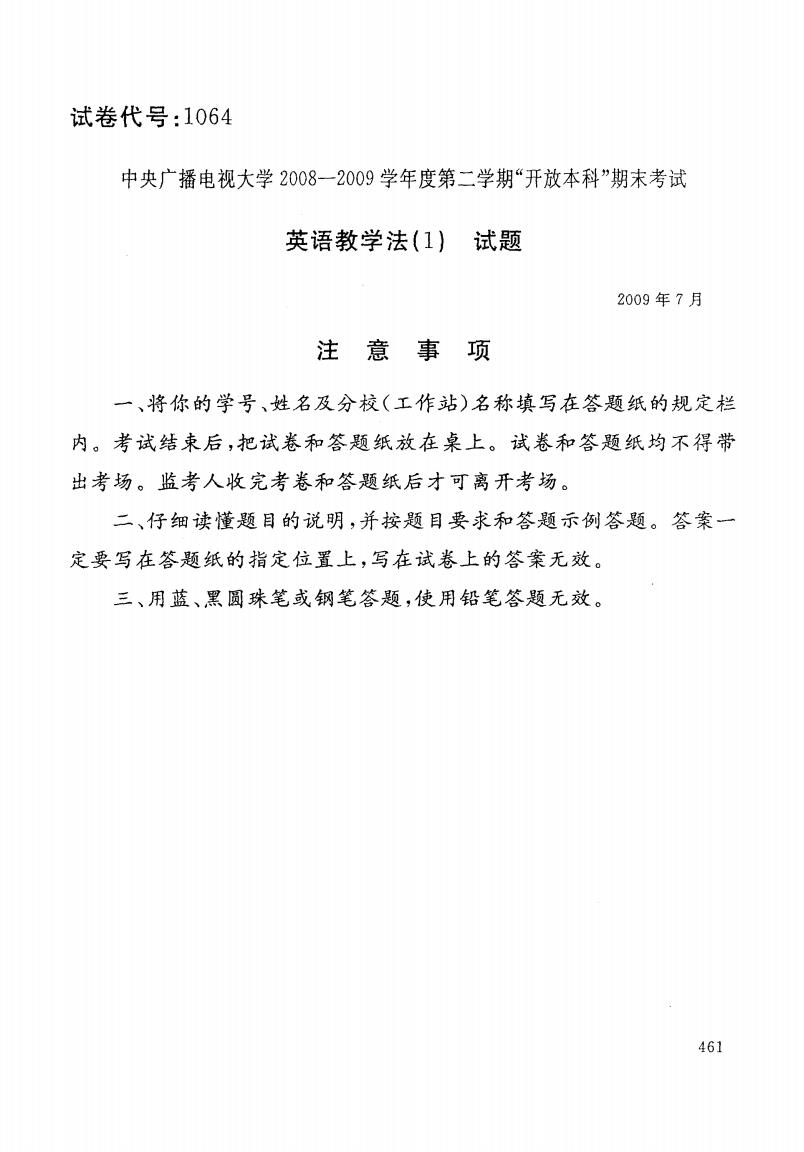
试卷代号:1064 中央广播电视大学2008一2009学年度第二学期“开放本科”期末考试 英语教学法(1)试题 2009年7月 注意事项 一、将你的学号、姓名及分校(工作站)名称填写在答题纸的规定档 内。考试结束后,把试卷和答题纸放在桌上。试卷和答题纸均不得带 出考场。监芳人收完考卷和答题纸后才可离开考场。 二、仔细读懂题目的说明,并按题目要求和答题示例答题。答案一 定要写在答题纸的指定位置上,写在试卷上的答案无效。 三、用蓝、黑圆珠笔或钢笔答题,使用铅笔答题无效。 461
试卷代号:1064 中央广播电视大学2008-2009学年度第二学期“开放本科”期末考试 英语教学法(1) 试题 2009年 7月 户闷卜 .攀毖 '怡' 'r= I土 左己 .月日. J夕之 一、将你的学号、姓名及分校(工作站)名称填写在答题纸的规定栏 内。考试结束后,把试卷和答题纸放在桌上。试卷和答题纸均不得带 出考场。监考人收完考卷和答题纸后才可离开考场。 二、仔细读懂题目的说明,并按题 目要求和答题示例答题。答案一 定要写在答题纸的指定位置上,写在试卷上的答案无效。 三、用蓝、黑圆珠笔或钢笔答题 ,使用铅笔答题无效
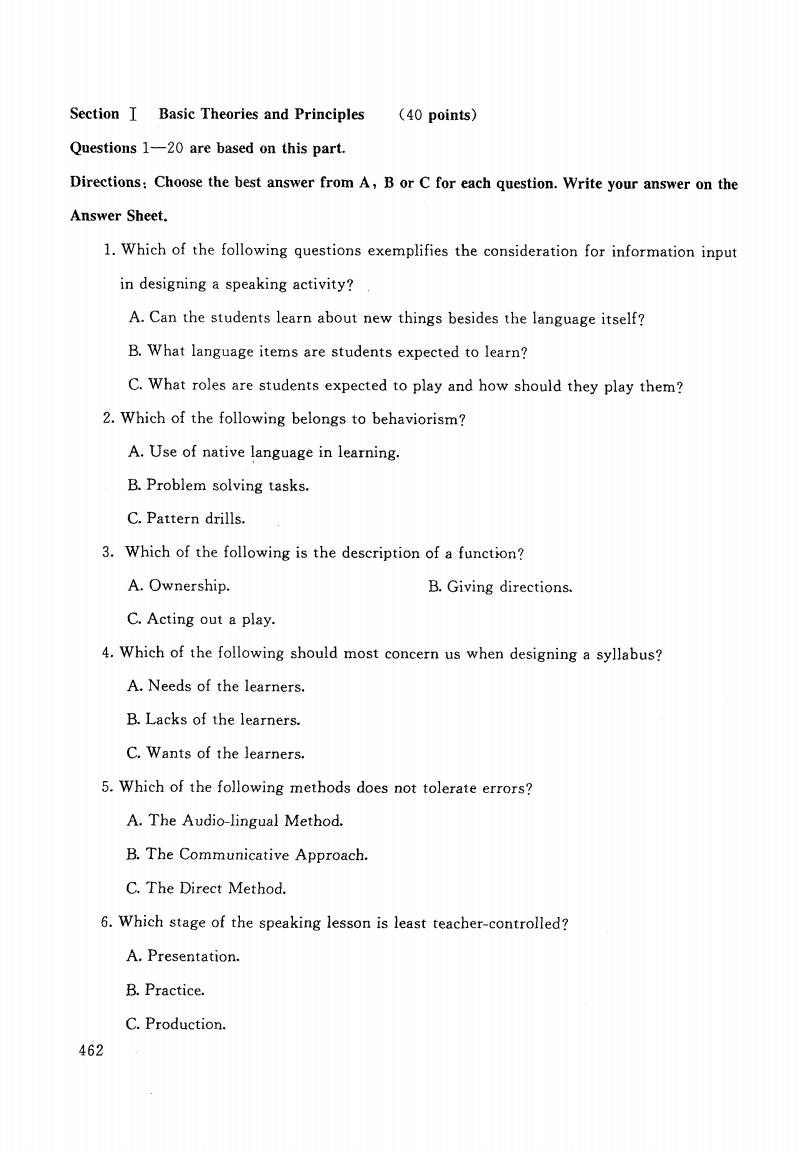
Section I Basic Theories and Principles (40 points) Questions 1-20 are based on this part. Directions:Choose the best answer from A,B or C for each question.Write your answer on the Answer Sheet. 1.Which of the following questions exemplifies the consideration for information input in designing a speaking activity? A.Can the students learn about new things besides the language itself? B.What language items are students expected to learn? C.What roles are students expected to play and how should they play them? 2.Which of the following belongs to behaviorism? A.Use of native language in learning. B.Problem solving tasks. C.Pattern drills. 3.Which of the following is the description of a function? A.Ownership. B.Giving directions. C.Acting out a play. 4.Which of the following should most concern us when designing a syllabus? A.Needs of the learners. B.Lacks of the learners. C.Wants of the learners. 5.Which of the following methods does not tolerate errors? A.The Audio-lingual Method. B.The Communicative Approach. C.The Direct Method. 6.Which stage of the speaking lesson is least teacher-controlled? A.Presentation. B.Practice. C.Production. 462
Section j Basic Theories and Principles (40 points) Questions 1-20 are based on this part. Directions. Choose the best answer from A,B or C for each question. Write your answer on the Answer Sheet. l. Which of the following questions exemplifies the consideration for information input in designing a speaking activity? A. Can the students learn about new things besides the language itself? B. What language items are students expected to learn? C. What roles are students expected to play and how should they play them? 2. Which of the following belongs to behaviorism? A. Use of native language in learning. B. Problem solving tasks. C. Pattern drills. 3. Which of the following is the description of a function? A. Ownership. B. Giving directions. C. Acting out a play. 4. Which of the following should most concern us when designing a syllabus? A. Needs of the learners. B. Lacks of the learners. C. Wants of the learners. 5. Which of the following methods does not tolerate errors? A. The Audio-lingual Method. B. The Communicative Approach. C. The Direct Method. 6. Which stage of the speaking lesson is least teacher-controlled? A. Presentation. B. Practice. C. Production. 462
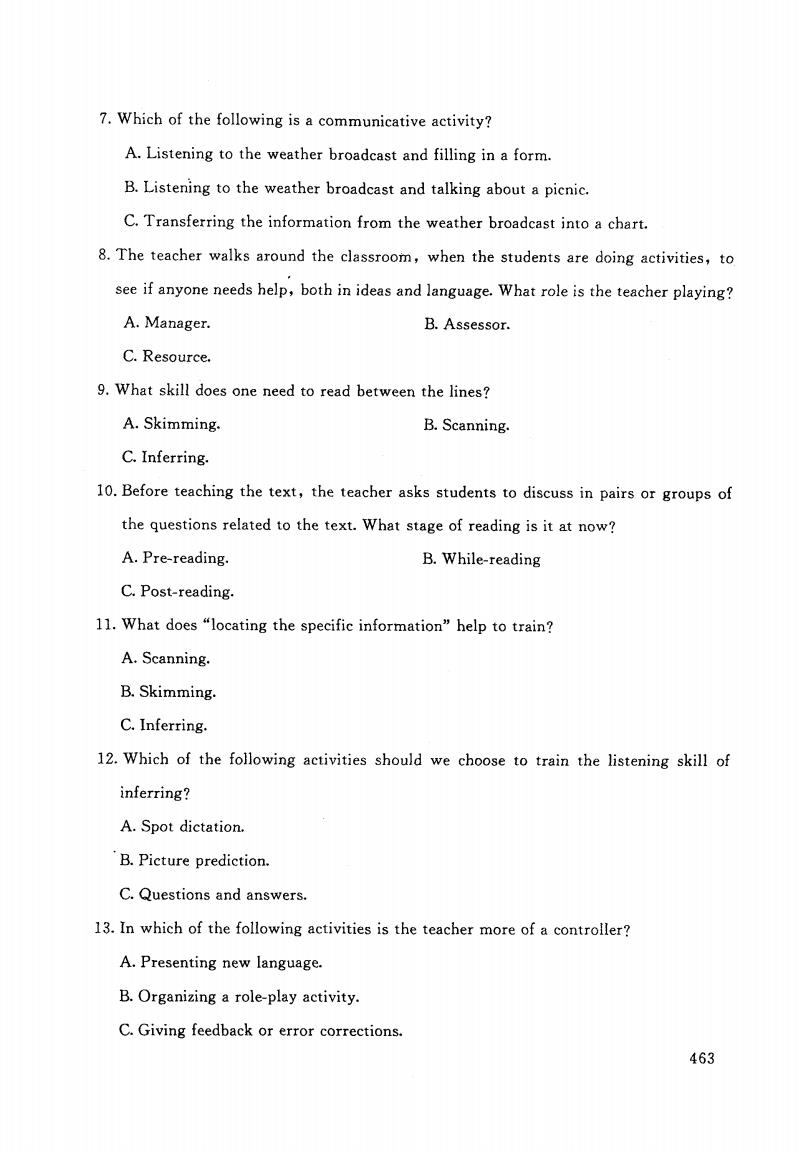
7.Which of the following is a communicative activity? A.Listening to the weather broadcast and filling in a form. B.Listening to the weather broadcast and talking about a picnic C.Transferring the information from the weather broadcast into a chart. 8.The teacher walks around the classroom,when the students are doing activities,to see if anyone needs help,both in ideas and language.What role is the teacher playing? A.Manager. B.Assessor. C.Resource. 9.What skill does one need to read between the lines? A.Skimming. B.Scanning. C.Inferring. 10.Before teaching the text,the teacher asks students to discuss in pairs or groups of the questions related to the text.What stage of reading is it at now? A.Pre-reading. B.While-reading C.Post-reading. 11.What does "locating the specific information"help to train? A.Scanning. B.Skimming. C.Inferring. 12.Which of the following activities should we choose to train the listening skill of inferring? A.Spot dictation. B.Picture prediction. C.Questions and answers. 13.In which of the following activities is the teacher more of a controller? A.Presenting new language. B.Organizing a role-play activity. C.Giving feedback or error corrections. 463
7. Which of the following is a communicative activity? A. Listening to the weather broadcast and filling in a form. B. Listening to the weather broadcast and talking about a picnic. C. Transferring the information from the weather broadcast into a chart. 8. The teacher walks around the classroom,when the students are doing activities, to see if anyone needs help, both in ideas and language. What role is the teacher playing? A. Manager. B. Assessor. C. Resource. 9. W hat skill does one need to read between the lines? A. Skimming. B. Scanning. C. Inferring. 10. Before teaching the text, the teacher asks students to discuss in pairs or groups of the questions related to the text. What stage of reading is it at now? A. Pre-reading. B. While-reading C. Post-reading. 11. What does "locating the specific information" help to train? A. Scanning. B. Skimming. C. Inferring. 12. Which of the following activities should we choose to train the listening skill of inferring? A. Spot dictation. B. Picture prediction. C. Questions and answers. 13. In which of the following activities is the teacher more of a controller? A. Presenting new language. B. Organizing a role-play activity. C. Giving feedback or error corrections. 463
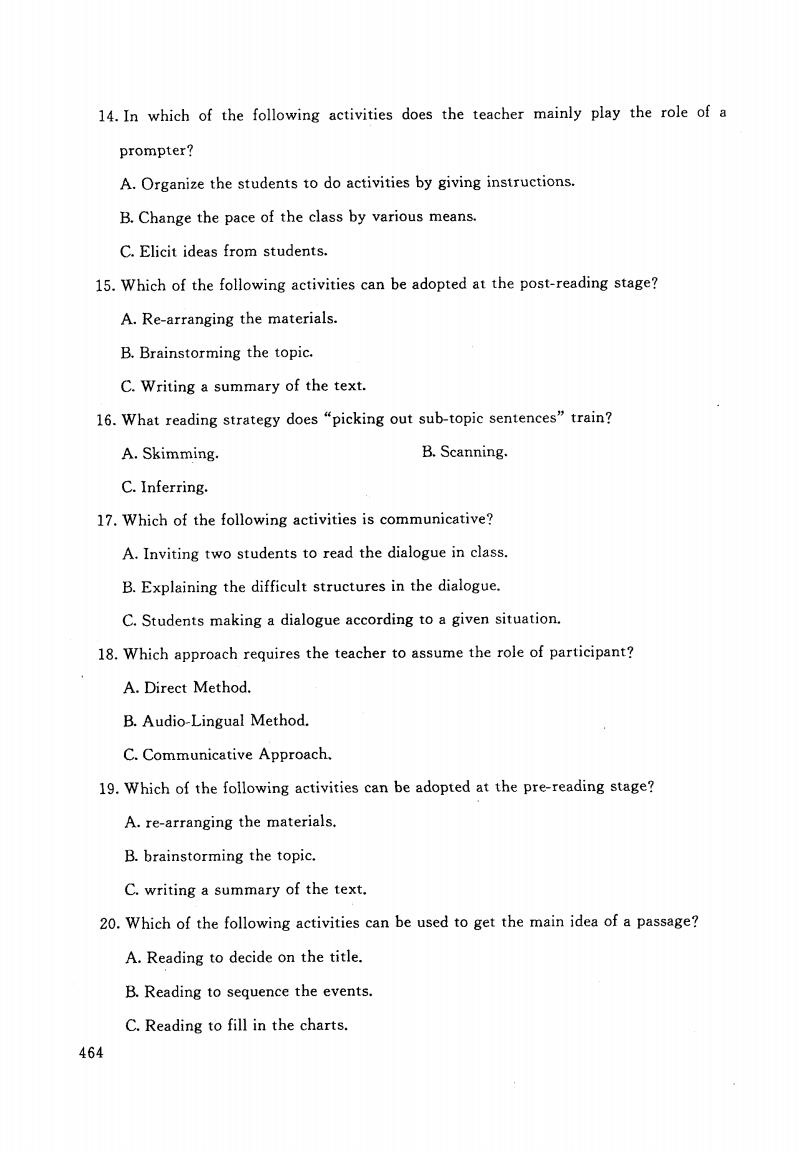
14.In which of the following activities does the teacher mainly play the role of a prompter? A.Organize the students to do activities by giving instructions. B.Change the pace of the class by various means. C.Elicit ideas from students. 15.Which of the following activities can be adopted at the post-reading stage? A.Re-arranging the materials. B.Brainstorming the topic. C.Writing a summary of the text. 16.What reading strategy does "picking out sub-topic sentences"train? A.Skimming. B.Scanning. C.Inferring. 17.Which of the following activities is communicative? A.Inviting two students to read the dialogue in class. B.Explaining the difficult structures in the dialogue. C.Students making a dialogue according to a given situation. 18.Which approach requires the teacher to assume the role of participant? A.Direct Method. B.Audio-Lingual Method. C.Communicative Approach. 19.Which of the following activities can be adopted at the pre-reading stage? A.re-arranging the materials. B.brainstorming the topic. C.writing a summary of the text. 20.Which of the following activities can be used to get the main idea of a passage? A.Reading to decide on the title. B.Reading to sequence the events C.Reading to fill in the charts. 464
14. In which of the following activities does the teacher mainly play the role of a prompter? A. Organize the students to do activities by giving instructions. B. Change the pace of the class by various means. C. Elicit ideas from students. 15. Which of the following activities can be adopted at the post-reading stage? A. Re-arranging the materials. B. Brainstorming the topic. C. Writing a summary of the text. 16. What reading strategy does "picking out sub-topic sentences" train? A. Skimming. C. Inferring. B. Scanning. 17. Which of the following activities is communicative? A. Inviting two students to read the dialogue in class. B. Explaining the difficult structures in the dialogue. C. Students making a dialogue according to a given situation. 18. Which approach requires the teacher to assume the role of participant? A. Direct Method. B. Audio-Lingual Method. C. Communicative Approach. 19. Which of the following activities can be adopted at the pre-reading stage? A. re-arranging the materials. B. brainstorming the topic. C. writing a summary of the text. 20. Which of the following activities can be used to get the main idea of a passage? A. Reading to decide on the B. Reading to sequence the title. events. C. Reading to fill in the charts. 464

SectionⅡ(60 points) Directions:In this section,you are presented with a short passage about Beckham.Read the passage and design three reading activities:one pre-reading activity,one reading activity and one post-reading activity.The requirement of each activity is as follows: Pre-reading:lead in the topic,prediction. Reading:understand the details about Beckham. Post-reading:train the ability to express attitudes and comments. You may follow the table given after the passage.Make sure the three activities are related to each other. David Beckham As a Real Madrid player,David Beckham is used to winning,and failure is something that he is simply unaccustomed to.He is one of the most famous Englishmen in the World today. Of course,it is impossible to have an unbiased opinion of this young man or the team that he plays for.If you are a Real Madrid fan,you love him.If you aren't a fan of this team, then your opinion of Mr.Beckham may be quite different.In fact,in recent times,his treatment by fans of other teams has been extremely unpleasant,especially when he has been playing for England.Some of the worst comments have not even been aimed at Beckham but at his wife and young children,which is a bad thing.It has been hard for the football authorities to control such unruly behavior.How can you discipline people for their comments when so many people are guilty? Beckham's attitude when faced with such problems has been calm though.Under the pressure of being shouted and sworn at by so many people,he has always remained calm. Of course,a lot of the bad things written and said about Beckham are due to his own actions.He is a very fashionable young man,but some of the clothes he has worn have been simply amazing.Why a person in his position would choose to wear a skirt in public is truly difficult to understand!Furthermore,to wear such things in unsuitable times as mid-winter seems even crazier! His behavior on the football pitch has also been unpredictable at times.Sometimes he is brilliant;sometimes he does crazy things.Some of the most famous footballing incidents involving Beckham are not his spectacular goals but his awkward tackles.The most famous occasion was in France'98,when a clumsy tackle led to him being sent off. 465
Section If (60 points) Directions:In this section, you are presented with a short passage about Beckham. Read the passage and design three one pre-reading activity, one reading activity and one post-reading activity. Pre-reading: lead in reading activities; The requirementof each activity is as follows: the Reading; understand the topic, prediction. details about Beckham : . Post-reading: train the ability to express attitudes and comments. You may follow the table given after the passage. Make sure the three activities are related to each other. David Beckham As a Real Madrid player, David Beckham is used to winning, and failure is something that he is simply unaccustomed to. He is one of the most famous Englishmen in the World today. Of course, it is impossible to have an unbiased opinion of this young man or the team that he plays for. If you are a Real Madrid fan, you love him. I# you aren't a fan of this team, then your opinion of Mr. Beckham may be quite different. In fact, in recent times, his treatment by fans of other teams has been extremely unpleasant,especially when he has been playing for England. Some of the worst comments have not even been aimed at Beckham but at his wife and young children, which is a bad thing. It has been hard for the football authorities to control such unruly behavior. How can you discipline people for their comments when so many people are guilty? Beckham's attitude when faced with such problems has been calm though. Under the pressure of being shouted and sworn at by so many people, he has always remained calm. Of course, a lot of the bad things written and said about Beckham are due to his own actions. He is a very fashionable young man, but some of the clothes he has worn have been simply amazing. Why a person in his position would choose to wear a skirt in public is truly difficult to understand! Furthermore,to wear such things in unsuitable times as mid-winter seems even crazier! His behavior on the football pitch has also been unpredictable at times. Sometimes he is brilliant; sometimes he does crazy things. Some of the most famous footballing incidents involving Beckham are not his spectacular goals but his awkward tackles. The most famous occasion was in France '98,when a clumsy tackle led to him being sent off. 465

Activity 1 (Pre-reading) Objectives: Classroom organization Teaching aid Procedure 3. Transition (how to relate to the following activity) Activity 2 (Reading) Objectives: Classroom organization Teaching aid Transition (how to relate to the former activity) 1. Procedure 2 Transition (how to relate to the following activity) Activity 3 (Post-reading) Objectives: Classroom organization Teaching aid Transition how to relate to the former activity) 1. Procedure 3 Backup plan: 1.Predicted problems. 2.Possible solutions. 466
Activity 1 (Pre-reading) Objectives: Classroom organization Teaching aid Procedure 1. 2. 3. Transition(how to relate to the following activity) Activity 2 (Reading) Objectives: Classroom organization Teaching aid Transition (how to relate to the former activity) Procedure 1. 2. 3. Transition(how to relate to the following activity) Activity 3 (Post-reading) Objectives: Classroom organization Teaching aid Transition (how to relate to the former activity) Procedure 1. 2. 3. Backup plan: 1. Predicted problems. 2. Possible solutions. 466
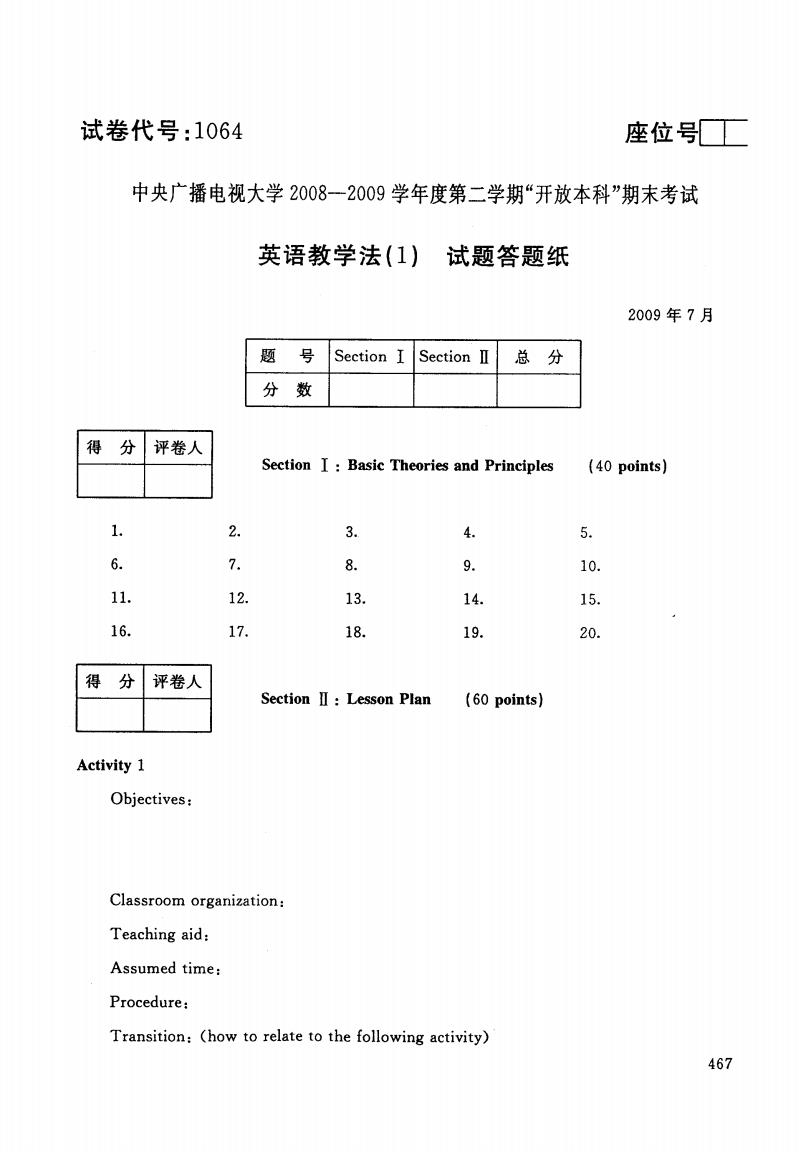
试卷代号:1064 座位号 中央广播电视大学2008一2009学年度第二学期“开放本科”期末考试 英语教学法(1)试题答题纸 2009年7月 题 尽 Section Section Ⅱ 总 分 分 数 得分 评卷人 Section I:Basic Theories and Principles (40 points) 1. 2. 3. 4. 5. 6. 7. 8. 9. 10. 11. 12. 13. 14. 15. 16. 17. 18. 19. 20. 得分 评卷人 SectionⅡ:Lesson Plan (60 points) Activity 1 Objectives: Classroom organization: Teaching aid: Assumed time: Procedure: Transition:(how to relate to the following activity) 467
试卷代号:1064 座位号口二 中央广播电视大学2008-2009学年度第二学期“开放本科”期末考试 英语教学法(1) 试题答题纸 2009年 7月 题 号 Section I Section I 总 分 分 数 得 分 评卷人 Section I:Basic Theories and Principles (40 points) . n ︺ 匕d ﹄U 尸0 1,1 1 上 9 口 : 。 。 连 ‘ 0 以 左 人 O U ..1 , .︷ : : O d n6 nj CO 工.1 吃.止 , . n乙 勺产 9 自 月了 ,,人 ..上 : : 1 止 丹匕 ,.︷ 魂b ..上 ,1 Section I:Lesson Plan (60 points) Activity 1 Objectives: Classroom organization: Teaching aid: Assumed time: Procedure: Transition: (how to relate to the following activity) 467

Activity 2 Objectives: Classroom organization: Teaching aid: Assumed time: Transition:(how to relate to the former activity) Procedure: Transition:(how to relate to the following activity) Activity 3 Objectives: Classroom organization: Teaching aid: Assumed time: Transition:(how to relate to the former activity) Procedure: Backup plan: 1.Predicted problems 2.Possible solutions 468
Activity 2 Objectives: Classroom organization: Teaching aid: Assumed time Transition: (how to relate to the former activity) Procedure: Transition: (how to relate to the following activity) Activity 3 Objectives: Classroom organization: Teaching aid: Assumed time: Transition: (how to relate to the former activity) Procedure: Backup plan: 1. Predicted problems 2. Possible solutions
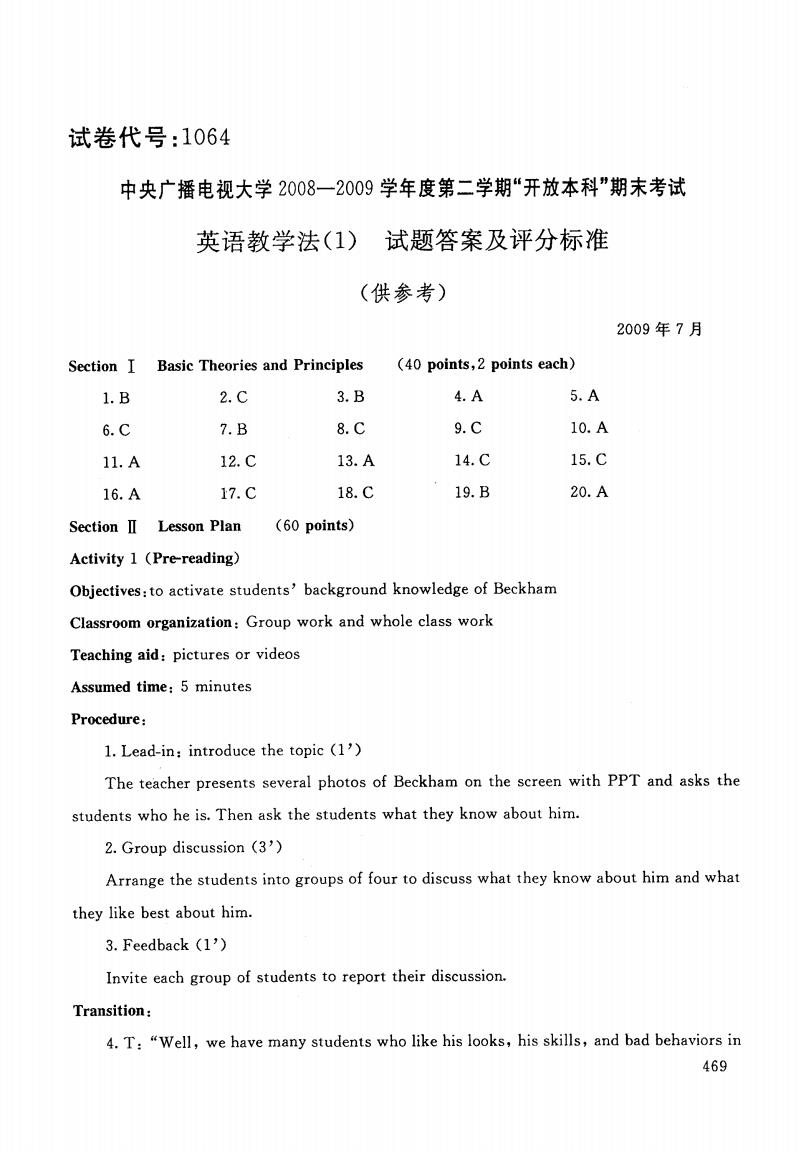
试卷代号:1064 中央广播电视大学2008一2009学年度第二学期“开放本科”期末考试 英语教学法(1)试题答案及评分标准 (供参考) 2009年7月 Section I Basic Theories and Principles (40 points,2 points each) 1.B 2.C 3.B 4.A 5.A 6.C 7.B 8.C 9.C 10.A 11.A 12.C 13.A 14.C 15.C 16.A 17.C 18.C 19.B 20.A SectionⅡ Lesson Plan (60 points) Activity 1(Pre-reading) Objectives:to activate students'background knowledge of Beckham Classroom organization:Group work and whole class work Teaching aid:pictures or videos Assumed time:5 minutes Procedure: 1.Lead-in:introduce the topic (1') The teacher presents several photos of Beckham on the screen with PPT and asks the students who he is.Then ask the students what they know about him. 2.Group discussion (3') Arrange the students into groups of four to discuss what they know about him and what they like best about him. 3.Feedback (1') Invite each group of students to report their discussion. Transition: 4.T:"Well,we have many students who like his looks,his skills,and bad behaviors in 469
试卷代号 :1064 中央广播电视大学2008-2009学年度第二学期“开放本科”期末考试 英语教学法(1) 试题答案及评分标准 (供参考) 2009年 7月 Section T Basic Theories and Principles (40 points, 2 points each) 1. B 6.C 2. C 3. B 4. A 5. A 7. B 8. C 9. C : A 0 1匕 ︸. 止 1 1 11. A 16. A 12. C 17. C 13. A 18. C 14. C 19. B C 20. A Section I Lesson Plan (60 points) Activity 1 (Pre-reading) Objectives:to activate students' background knowledge of Beckham Classroom organization: Group work and whole class work Teaching aid: pictures or videos Assumed time: 5 minutes Procedure: 1. Lead-in: introduce the topic (1’) The teacher presents several photos of Beckham on the screen with PPT and asks the students who he is. Then ask the students what they know about him. 2. Group discussion (3’) Arrange the students into groups of four to discuss what they know about him and what they like best about him. 3. Feedback (1’) Invite each group of students to report their discussion. Transition 4. T: "Well,we have many students who like his looks, his skills, and bad behaviors in 469
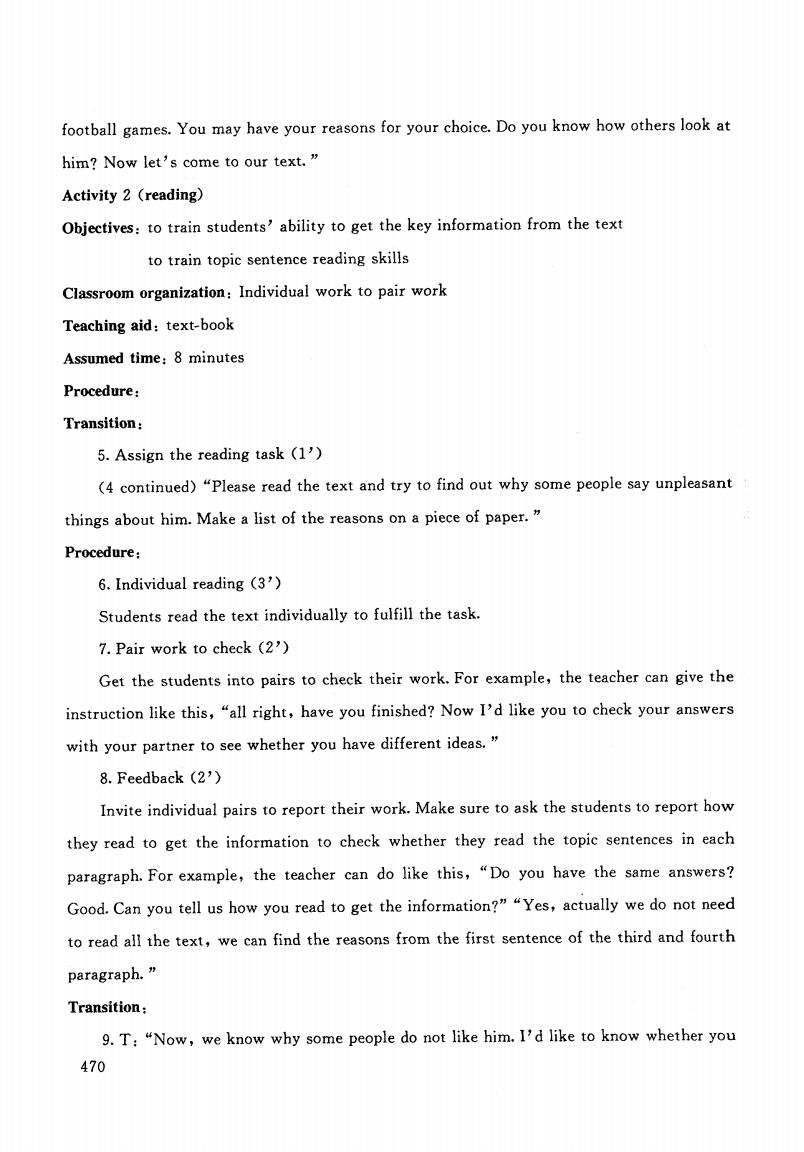
football games.You may have your reasons for your choice.Do you know how others look at him?Now let's come to our text." Activity 2 (reading) Objectives:to train students'ability to get the key information from the text to train topic sentence reading skills Classroom organization:Individual work to pair work Teaching aid:text-book Assumed time:8 minutes Procedure: Transition: 5.Assign the reading task (1') (4 continued)"Please read the text and try to find out why some people say unpleasant things about him.Make a list of the reasons on a piece of paper." Procedure: 6.Individual reading (3') Students read the text individually to fulfill the task. 7.Pair work to check (2') Get the students into pairs to check their work.For example,the teacher can give the instruction like this,"all right,have you finished?Now I'd like you to check your answers with your partner to see whether you have different ideas. 8.Feedback(2') Invite individual pairs to report their work.Make sure to ask the students to report how they read to get the information to check whether they read the topic sentences in each paragraph.For example,the teacher can do like this,"Do you have the same answers? Good.Can you tell us how you read to get the information?""Yes,actually we do not need to read all the text,we can find the reasons from the first sentence of the third and fourth paragraph.” Transition: 9.T:"Now,we know why some people do not like him.I'd like to know whether you 470
football games. You may have your reasons for your choice. Do you know how others look at him? Now let's come to our text.” Activity 2 (reading) Objectives: to train students' ability to get the key information from the text to train topic sentence reading skills Classroom organization: Individual work to pair work Teaching aid: text-book Assumed time: 8 minutes Procedure: Transition: 5. Assign the reading task (I’) (4 continued) "Please read the text and try to find out why some people say unpleasant things about him. Make a list of the reasons on a piece of paper.” Procedure: 6. Individual reading (3’) Students read the text individually to fulfill the task. 7. Pair work to check (2’) Get the students into pairs to check their work. For example, the teacher can give the instruction like this, "all right, have you finished? Now I'd like you to check your answers with your partner to see whether you have different ideas.” 8. Feedback (2’) Invite individual pairs to report their work. Make sure to ask the students to report how they read to get the information to check whether they read the topic sentences in each paragraph. For example, the teacher can do like this,“Do you have the same answers? Good. Can you tell us how you read to get the information?" "Yes, actually we do not need to read all the text, we can find the reasons from the first sentence of the third and fourth paragraph.” Transition . 9. T: "Now, we know why some people do not like him. I'd like to know whether you 470